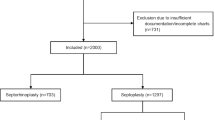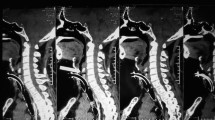Abstract
No surgery is free of complications varying from common minor problems to very unexpected and severe ones. In the case presented here, unilateral paralysis of the muscles of the tongue and ipsilateral vocal cord paralysis due to a lesion of the 10th and 12th cranial nerves occurred following a septorhinoplasty that was performed under endotracheal general anesthesia. This rare entity known as Tapia’s Syndrome is believed to be caused by pressure neuropathy of both nerves due to inflation of the cuff within the larynx. We remind surgeons of this unusual complication that can occur in any surgery under general anesthesia and discuss its diagnosis, treatment method, and the followup results in light of the literature.

Similar content being viewed by others
References
Baumgarten V, Jalinski W, Bohm S, Galle E: Hypoglossal paralysis after septum correction with intubation anaethesia. Der Anaesthesist 46:34–37, 1997
Dearing J: Transient contralateral hypoglossal nerve palsy following third molar surgery under day-case general anaesthesia: a case report and review of the literature. Br J Oral Maxillofac Surg 36:24–26, 1998
Gelmers HJ: Tapia’s syndrome after thoracotomy. Arch Otolaryngol 109:622–623, 1989
Keane JR: Twelfth nerve palsy: analysis of 100 cases. Arch Neurol 53:561–566, 1996
Lagalla G, Logullo F, Di Bella P, Provinciali L, Ceravolo MG: Influence of early high dose steroid treatment on Bell’s palsy evolution. Neurol Sci 23:107– 112, 2002
Lu YH, Hsieh MW, Tong YH: Unilateral vocal cord paralysis following endotracheal intubation—a case report. Acta Anaesthesiol Sin 37:221–224, 1999
O’Brien JP, Yau ACMC, Hodgson AR: Halo pelvic traction: A technic for severe spinal deformities. Clin Orthop 93:179–190, 1973
Ono S, Nishiyama T, Hanaoka K: Hoarseness after endotracheal intubation caused by submucosal hemorrage of the vocal cord and reccurent nerve palsy. Masui 49:881–883, 2000
Rubio-Nazabal E, Marey-Lopez J, Lopez-Facal S, Alverez-Perez P, Martinez-Fiqueroa A, Rey del Corral P: Isolated bilateral paralysis of the hypoglossal nerve after transoral intubation for general anesthesia. 96:245–247, 2002
Stewart A, Lindsay WA: Bilateral hypoglossal nerve injury following the use of the laryngeal mask airway. Anaesthesia 57:264–265, 2002
Streppel M, Bachmann G, Stennert E: Hypoglossal nerve palsy as a complication of transoral intubation for general anaesthesia. Anesthesiology 86:1007, 1997
Tapia AG: Un caso de paralisis del lado derecho de la laringe y de la ungue, con paralisis del externo-cleidomastoidea y trapecio del mismo lado. Siglo Medica 52:211–213, 1905
Venkatesh B, Walker D: Hypoglossal neuropraxia following endotracheal intubation. Anaesth Intensive Care 25:699–700, 1997
Wael BK, Mayerson J, Gordon BR: Cranial nerve palsy as a complication of operative traction. Spine 24:585–586, 1999
Author information
Authors and Affiliations
Corresponding author
Rights and permissions
About this article
Cite this article
Yavuzer, R., Başterzi, Y., Æzköse, Z. et al. Tapia’s Syndrome Following Septorhinoplasty . Aesth. Plast. Surg. 28, 208–211 (2004). https://doi.org/10.1007/s00266-003-3037-7
Published:
Issue Date:
DOI: https://doi.org/10.1007/s00266-003-3037-7




